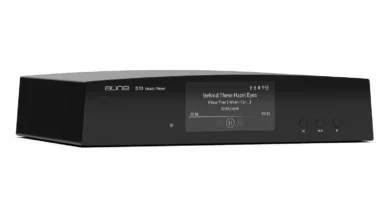What is Non oversampling (NOS): Everything You Need to Know

Non-oversampling (NOS) is a digital-to-analog conversion (DAC) process that skips the interpolation or oversampling process. It is commonly used in new models of digital audio systems. Instead of upscaling the digital audio signal, a Non-oversampling (NOS) DAC processes the signal directly at its native resolution and sample rate.
What is Non-Oversampling (NOS) and How Does it Work?
A Non-oversampling (NOS) is a digital-to-analog conversion (DAC) process that skips the interpolation or oversampling process. It is commonly used in new models of digital audio systems. Instead of upscaling the digital audio signal, a Non-oversampling (NOS) DAC processes the signal directly at its native resolution and sample rate.
A Non-Oversampling (NOS) DAC works by converting digital audio signals directly into analog signals without altering or changing the original sample rate or bit depth.
Here are some methods that how Non-Oversampling DAC works
1. Direct Signal Processing
- Non-oversampling DAC receives the digital audio signal and converts it into the same bit rate a standard sample rate like 44.1 kHz or 48 kHz, is fed directly to the DAC.
- On the other hand oversampling DACs, which interpolate additional data points between existing samples, a NOS DAC processes only the original samples.
2. Conversion to Analog
Next is conversion to analog
- The Non-oversampling DAC receives the digital signal and is passed through a digital-to-analog converter chip, where each digital sample is transformed into an analog voltage level.
- This results in a “stepped” waveform that represents the original audio signal.

3. Analog Smoothing
- To smooth out the stepped waveform and remove unwanted high-frequency components (such as aliasing noise), a simple analog filter is applied.
- Unlike oversampling DACs, which rely heavily on digital filters for this task, NOS DACs use analog circuits, often prioritizing simplicity and sound quality.

Characteristics of Non-Oversampling (NOS):
Now let’s have a look at some key features of Non-Oversampling
First is Direct Conversion: In direct conversion Non-Oversampling (NOS) DACs give the output audio signals without altering the original sample rate or bit rate depth.
Simplicity: Depends on simple circuit designs with fewer digital processing steps depending. designs.
No Digital Filtering: Non oversampling DACs bypass the digital filter which is commonly used in oversampling systems.
Focus on Analog Sound: The focus is on analog filtering and a purer signal path.
What are NOS DACs?
A Non oversampling DAC is a digital-to-analog converter without an oversampler. Sometimes, without an analog filter. Unlike standard DACs that upsample digital audio signals to a higher rate for processing, NOS DACs convert the audio signal directly at its original sample rate and bit depth without any digital interpolation
This Non-oversampling Guide aims to help beginners know the concept of NOS technology and understand its potential in audio systems. Read below why the NOS digital-to-analog converter is used, its types, advantages and disadvantages, comparison of oversampling vs non-oversampling DAC (DAC with and without oversampling).
Why do you need NOS DAC?
Traditionally, the PCM digital-to-analog converter contains an oversampled to use the analog filter more effectively. Because the analog filter is a mandatory part of PCM and DSD DAC.
A non-oversampling digital-to-analog converter is used to eliminate oversampling artifacts (distortions) ( digital filter ringing, unevenness of the amplitude-frequency response in the filter passband, and, in some cases, phase distortions). In essence, this is a regular DAC without an oversampled module and a digital filter.
Advantages and Disadvantages of Non-oversampling DACs
Now let’s talk about some advantages and disadvantages of Non oversampling DACs.
As we know non-oversamling DACs are very popular with audiophiles that’s why we,ve talked with some audiophiles and they say that the sound of NOS DACs is smoother and more natural. Because of their unique sound characteristics and perceived benefits.
Here are some key advantages and disadvantages associated with NOS DACs:
Advantages of Non-Oversampling (NOS) DACs
- Natural and Organic Sound
- Many audiophiles praise NOS DACs for their smooth, warm, and lifelike sound, often described as less “digital” compared to oversampling DACs.
- Minimal Processing Artifacts
- By avoiding oversampling and digital filters, NOS DACs eliminate issues like pre-ringing and phase distortion, preserving the purity of the original audio signal.
- Simpler Circuit Design
- NOS DACs typically have fewer components, which can lead to a cleaner signal path and reduced electronic noise.
- Analog Emphasis
- The reliance on analog filtering rather than digital processing aligns with the preferences of purists who value analog sound characteristics.
- Lower Latency
- Without oversampling or additional processing steps, NOS DACs offer minimal delay, which can be advantageous in certain applications.
- Retro Appeal
- Often used in vintage-inspired or DIY audio projects, NOS DACs cater to enthusiasts who appreciate a minimalist and old-school approach.
- Lower Power Consumption
- The lack of complex digital processing results in reduced power requirements, making NOS DACs more energy-efficient.
Disadvantages of Non-Oversampling (NOS) DACs
- High-Frequency Roll-Off
- Without oversampling, the output signal may lose detail in the higher frequencies, potentially impacting overall audio fidelity.
- Risk of Aliasing
- By skipping digital filters, NOS DACs can allow aliasing artifacts to become audible, particularly at higher volumes.
- Limited Compatibility
- NOS DACs may struggle with modern high-resolution audio formats or advanced streaming technologies designed for oversampling systems.
- Dependence on Analog Filters
- The quality of the sound relies heavily on the design and implementation of the analog filter, which can be challenging to perfect.
- Stepped Waveform Output
- The initial output from a NOS DAC is a “stepped” waveform that requires smoothing, which might not achieve the same precision as oversampled DACs.
- Niche Appeal
- NOS DACs cater to a specific subset of audiophiles and may not satisfy listeners who prefer technical perfection or compatibility with cutting-edge audio formats.
- Subjective Sound Quality
- While some enjoy the “organic” sound, others might perceive NOS DACs as less detailed or technically accurate compared to oversampling models.
Non-oversampling DAC and upsampling
In practice, we have a limited number of recording resolutions (sampling rates) that are downloaded from online stores or after CD ripping. In order to prepare these recordings for playback with a NOS DAC, these audio files need to be resampled (increase the sampling rate of the recordings to a value compatible with this digital-to-analog converter).
Resampling on a personal computer (even a laptop) can give audio developers more resources for more accurate digital processing of the audio signal. But the quality of audio is determined not only by the available computing resources. Because resampling filters can be implemented in different ways.
The Significance of Digital Filters in Digital-to-Analog Conversion
Digital filters are essential for converting digital audio signals to analog waveforms. Their main purpose is to eliminate undesired frequencies and artifacts introduced during the digital processing stages. In NOS DACs, these filters play a crucial role in shaping the analog output by reducing high-frequency noise and aliasing distortion.
One important factor to consider when it comes to digital filters is their roll-off characteristics. The roll-off refers to how quickly the filter decreases the volume of frequencies above its cutoff point. Filters with steeper roll-off slopes have a more pronounced reduction of higher frequencies, which helps in minimizing aliasing distortion but may also impact high-frequency content.
How Different Types of Digital Filters Affect the Sound of NOS DACs
VariouIn Non-Oversampling (NOS) DACs, digital filters are typically omitted in favor of simplicity, relying instead on analog filters to handle post-conversion processing. However, in cases where digital filters are applied (e.g., hybrid NOS designs), the type of filter used can significantly influence the sound signature. Here’s how different types of digital filters might affect the sound of NOS DACs:
1. Linear Phase Filters
- Characteristics:
Linear phase filters maintain phase accuracy, ensuring that all frequencies are delayed by the same amount during processing. - Sound Impact:
- Clear and precise imaging with accurate soundstage reproduction.
- Can introduce pre-ringing, which some listeners perceive as unnatural, particularly in transients (like percussion sounds).
- Common Use:
Rare in NOS DACs since they contradict the purist approach, but occasionally used in hybrid designs.
2. Minimum Phase Filters
- Characteristics:
These filters focus on eliminating pre-ringing by allowing some phase distortion (non-linear phase). - Sound Impact:
- Transients sound more natural and dynamic.
- Slightly altered spatial cues due to phase shifts, which may affect the soundstage.
- Common Use:
Preferred in designs aiming to balance natural sound with technical performance.
3. Slow Roll-Off Filters
- Characteristics:
Slow roll-off filters have a gentler frequency cutoff, allowing some high-frequency content (including aliasing) to pass through. - Sound Impact:
- Warmer and more analog-like sound.
- Less precise high-frequency detail, which may soften the overall presentation.
- Common Use:
Often associated with NOS designs for their smooth and relaxed sound signature.
4. Fast Roll-Off Filters
- Characteristics:
These filters have a steep frequency cutoff, effectively suppressing high-frequency artifacts like aliasing. - Sound Impact:
- Detailed and accurate sound reproduction with minimal distortion.
- Can sound analytical or harsh to some listeners.
- Common Use:
Rare in NOS DACs due to their more digital-sounding nature.
5. No Digital Filter (True NOS)
- Characteristics:
True NOS DACs completely bypass digital filters, leaving all post-conversion processing to the analog domain. - Sound Impact:
- Pure, unprocessed signal for a raw and organic listening experience.
- May introduce aliasing and frequency roll-off, especially at higher frequencies.
- Common Use:
Core to traditional NOS DAC philosophy.
Summary of Impact on NOS DAC Sound
- Filtered NOS DACs: Introduce a mix of digital and analog characteristics, allowing for customization of the sound signature (e.g., using minimum phase or slow roll-off filters for a warmer sound).
- Unfiltered NOS DACs: Offer the purest implementation of the NOS philosophy, emphasizing analog smoothness but with potential trade-offs like aliasing and high-frequency roll-off.
Choosing the Right Filter
The choice of filter (or lack thereof) in an NOS DAC depends on the listener’s preferences:
Balanced Dynamics: Consider a minimum phase filter.
Natural and Analog Sound: Opt for no digital filter or a slow roll-off filter.
Technical Precision: Use a fast roll-off or linear phase filter.
Pros and Cons of Non oversampling DAC
Pros of Non-Oversampling (NOS) DACs
- Natural Sound Quality
- Minimal Processing Artifacts
- Simple Design
- Low Latency
- Analog Emphasis
- Energy Efficient
- Unique Listening Experience
Cons of Non-Oversampling (NOS) DACs
- High-Frequency Roll-Off
- Aliasing
- Limited Compatibility
- Dependence on Analog Filtering
Comparing Non-Oversampling (NOS) and Oversampling DAC Architectures
When choosing between NOS and oversampling DACs, it’s essential to understand their architectural differences and how these impact sound quality, design, and user experience. Here’s a detailed comparison:
1. Signal Processing Approach
- NOS DACs:
- Convert the digital signal directly to analog without upsampling or interpolation.
- No digital filtering; relies on analog filters for post-conversion smoothing.
- Keeps the signal as “raw” and unaltered as possible.
- Oversampling DACs:
- Upsample the digital signal by adding interpolated data points, increasing the sample rate.
- Use digital filters to suppress aliasing and improve high-frequency performance.
- Outputs a smoother, more detailed waveform.
2. Sound Characteristics
- NOS DACs:
- Warm, natural, and organic sound with a more “analog-like” character.
- May experience high-frequency roll-off and aliasing artifacts.
- Appeals to purists who prefer minimal processing.
- Oversampling DACs:
- Precise and detailed sound with enhanced clarity, particularly in high frequencies.
- Can introduce digital artifacts like pre-ringing and phase distortion.
- Often perceived as more “clinical” or analytical.
3. Design Complexity
- NOS DACs:
- Simpler circuit design with fewer components and processing stages.
- Focuses on analog design quality (e.g., filters, power supplies).
- Easier to design for purists and DIY enthusiasts.
- Oversampling DACs:
- More complex, with additional digital signal processing stages.
- Requires advanced digital filtering algorithms and interpolation techniques.
- Demands higher computational power and precision engineering.
4. Performance and Compatibility
- NOS DACs:
- Limited to the original sample rate and bit depth of the input signal.
- Less suitable for modern high-resolution audio formats.
- May struggle with ultra-high sample rates or modern streaming platforms.
- Oversampling DACs:
- Excellent compatibility with high-resolution audio formats like DSD or 24-bit/192kHz PCM.
- Better at handling complex, high-sample-rate audio files without distortion.
5. Filtering and Noise Management
- NOS DACs:
- Depend on analog filters to smooth the output signal, which may not suppress aliasing as effectively.
- Can introduce high-frequency noise if poorly designed.
- Oversampling DACs:
- Digital filters handle most of the noise management, effectively suppressing aliasing.
- Analog filters have a less critical role, often simpler in design.
6. Power Consumption
- NOS DACs:
- Lower power requirements due to the lack of oversampling and digital processing.
- Oversampling DACs:
- Higher power consumption due to intensive digital signal processing.
7. Target Audience
- NOS DACs:
- Designed for audiophiles who value simplicity, natural sound, and minimal signal processing.
- Popular in vintage-inspired or niche audio setups.
- Oversampling DACs:
- Geared toward users seeking technical accuracy, high detail retrieval, and versatility with modern audio formats.
- Common in mainstream and professional audio systems.
Summary Table
| Feature | NOS DACs | Oversampling DACs |
|---|---|---|
| Signal Path | Direct conversion, no oversampling | Upsampling with digital filtering |
| Sound | Warm, organic, natural | Detailed, precise, analytical |
| Design | Simple, minimalistic | Complex, technology-driven |
| Compatibility | Limited to standard resolutions | Compatible with high-res formats |
| Filtering | Relies on analog filters | Uses digital filters |
| Noise Handling | Potential for aliasing artifacts | Suppresses noise effectively |
| Power Consumption | Low | Higher |
| Audience | Purists, vintage enthusiasts | High-res audio enthusiasts |
Which is Right for You?
- Choose NOS DACs if you:
- Prefer a warmer, more natural sound.
- Value simplicity and analog aesthetics.
- Don’t require support for high-resolution audio formats.
- Choose Oversampling DACs if you:
- Need precision, clarity, and support for modern formats.
- Want a versatile DAC for various audio setups.
- Prioritize technical accuracy over subjective warmth.
Both approaches have their strengths and weaknesses, so the best choice depends on your listening preferences and technical requirements.
Verdict
As we wind down, it’s important to note that audio is subjective and personal. Choosing between NOS or oversampling DACs ultimately depends on what kind of sound you’re looking for.
Before making decisions, I recommend exploring NOS DACs with open ears. You should experiment with different formats and see how they fit with your existing setup. Keep in mind that what sounds fantastic to some may not have the same effect on others.
If you want to ask more please let us know in the comment section below



